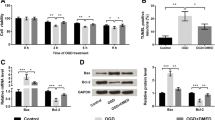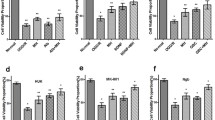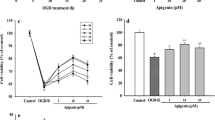Abstract
The brain ischemia/reperfusion (I/R) injury has a great impact on human life and property safety. As far as we know, mild hypothermia (MH) is an effective measure to reduce neuronal injury after I/R. However, the precise mechanism is not extremely clear. The purpose of this study was to investigate whether mild therapeutic hypothermia can play a protective role in nerve cells dealing with brain I/R injury and explore its specific mechanism in vitro. A flow cytometer, cell counting kit-8 (CCK-8) assay and lactate dehydrogenase (LDH) release assay were performed to detect apoptotic rate of cells, cell viability and cytotoxicity, respectively, reactive oxygen species (ROS) assay kit, JC-1 fluorescent methods, immunofluorescence and western blot were used to explore ROS, mitochondrial transmembrane potential (Δψm), mitochondrial permeability transition pore (MPTP) and protein expression, respectively. The result indicated that the cell activity was decreased, while the cytotoxicity and apoptosis rate were increased after treating with oxygen–glucose deprivation/reperfusion (OGD/R) in PC12 cells. However, MH could antagonize this phenomenon. Interestingly, treating with OGD/R increased the release of ROS and the transfer of Cytochrome C (Cyt-C) from mitochondria to cytoplasm. In addition, it up-regulated the expression of γH2AX, Bax and Clv-caspase3, down-regulated the expression of PCNA, Rad51 and Bcl-2, and inhibited the function of mitochondria in PC12 cells. Excitingly, the opposite trend was observed after MH treatment. Therefore, our results suggest that MH protects PC12 cells against OGD/R-induced injury with the mechanism of inhibiting cell apoptosis by reducing ROS production, improving mitochondrial function, reducing DNA damage, and enhancing DNA repair.







Similar content being viewed by others
Data availability
The data that support the findings of this study are available.
Abbreviations
- CCK-8:
-
Cell counting Kit-8
- Cyt-C:
-
Cytochrome C
- I/R:
-
Ischemia/reperfusion
- LDH:
-
Lactate dehydrogenase
- MH:
-
Mild hypothermia
- MPTP:
-
Mitochondrial permeability transition pore
- OGD/R:
-
Oxygen–glucose deprivation/reperfusion
- ROS:
-
Reactive oxygen species
- Δψm:
-
Mitochondrial transmembrane potential
References
Galkin A (2019) Brain ischemia/reperfusion injury and mitochondrial complex I damage. Biochemistry (Mosc) 84(11):1411–1423
Wang X, Fang Y, Huang Q et al (2021) An updated review of autophagy in ischemic stroke: from mechanisms to therapies. Exp Neurol 340:113684
Xiao Q, Ye Q, Wang W et al (2017) Mild hypothermia pretreatment protects against liver ischemia reperfusion injury via the PI3K/AKT/FOXO3a pathway. Mol Med Rep 16(5):7520–7526
Polderman KH (2009) Mechanisms of action, physiological effects, and complications of hypothermia. Crit Care Med 37(7 Suppl):S186-202
Yu H, Wu Z, Wang X et al (2020) Protective effects of combined treatment with mild hypothermia and edaravone against cerebral ischemia/reperfusion injury via oxidative stress and Nrf2 pathway regulation. Int J Oncol 57(2):500–508
Inamasu J, Ichikizaki K (2002) Mild hypothermia in neurologic emergency: an update. Ann Emerg Med 40(2):220–230
Zhou T, Liang L, Liang Y (2017) Mild hypothermia protects hippocampal neurons against oxygen-glucose deprivation/reperfusion-induced injury by improving lysosomal function and autophagic flux. Exp Cell Res 358(2):147–160
Zhou T, Lin H, Jiang L et al (2018) Mild hypothermia protects hippocampal neurons from oxygen-glucose deprivation injury through inhibiting caspase-3 activation. Cryobiology 80:55–61
Zhou T, Liang Y, Jiang L et al (2017) Mild hypothermia protects against oxygen glucose deprivation/reoxygenation-induced apoptosis via the Wnt/beta-catenin signaling pathway in hippocampal neurons. Biochem Biophys Res Commun 486(4):1005–1013
Shi H, Su Z, Su H et al (2021) Mild hypothermia improves brain injury in rats with intracerebral hemorrhage by inhibiting IRAK2/NF-kappaB signaling pathway. Brain Behav 11(1):e01947
Xiao Q, Ye QF, Wang W et al (2017) Mild hypothermia pretreatment protects hepatocytes against ischemia reperfusion injury via down-regulating miR-122 and IGF-1R/AKT pathway. Cryobiology 75:100–105
Tissier R, Chenoune M, Pons S et al (2013) Mild hypothermia reduces per-ischemic reactive oxygen species production and preserves mitochondrial respiratory complexes. Resuscitation 84(2):249–255
Srinivas US, Tan BWQ, Vellayappan BA et al (2019) ROS and the DNA damage response in cancer. Redox Biol 25:101084
Gavande NS, VanderVere-Carozza PS, Hinshaw HD et al (2016) DNA repair targeted therapy: the past or future of cancer treatment? Pharmacol Ther 160:65–83
Zhou D, Zhuang J, Wang Y et al (2019) Propofol alleviates DNA damage induced by oxygen glucose deprivation and reperfusion via FoxO1 nuclear translocation in H9c2 cells. Front Physiol 10:223
Bi J, Zhang J, Ren Y et al (2019) Irisin alleviates liver ischemia-reperfusion injury by inhibiting excessive mitochondrial fission, promoting mitochondrial biogenesis and decreasing oxidative stress. Redox Biol 20:296–306
Wang D, Wang Y, Zou X et al (2020) FOXO1 inhibition prevents renal ischemia-reperfusion injury via cAMP-response element binding protein/PPAR-gamma coactivator-1alpha-mediated mitochondrial biogenesis. Br J Pharmacol 177(2):432–448
Yin F, Zhou H, Fang Y et al (2020) Astragaloside IV alleviates ischemia reperfusion-induced apoptosis by inhibiting the activation of key factors in death receptor pathway and mitochondrial pathway. J Ethnopharmacol 248:112319
Czarny P, Wigner P, Galecki P et al (2018) The interplay between inflammation, oxidative stress, DNA damage, DNA repair and mitochondrial dysfunction in depression. Prog Neuropsychopharmacol Biol Psychiatry 80(Pt C):309–321
Migdady I, Rice C, Deshpande A et al (2020) Brain injury and neurologic outcome in patients undergoing extracorporeal cardiopulmonary resuscitation: a systematic review and meta-analysis. Crit Care Med 48(7):e611–e619
Yu SJ, Yu MJ, Bu ZQ et al (2021) MicroRNA-670 aggravates cerebral ischemia/reperfusion injury via the Yap pathway. Neural Regen Res 16(6):1024–1030
Liu X, Wen S, Zhao S et al (2018) Mild therapeutic hypothermia protects the brain from ischemia/reperfusion injury through upregulation of iASPP. Aging Dis 9(3):401–411
Hong JM, Choi ES, Park SY (2022) Selective brain cooling: a new horizon of neuroprotection. Front Neurol 13:873165
Yang S, Lian G (2020) ROS and diseases: role in metabolism and energy supply. Mol Cell Biochem 467(1–2):1–12
Minutoli L, Puzzolo D, Rinaldi M et al (2016) ROS-mediated NLRP3 inflammasome activation in brain, heart, kidney, and testis ischemia/reperfusion injury. Oxid Med Cell Longev 2016:2183026
Granger DN, Kvietys PR (2015) Reperfusion injury and reactive oxygen species: the evolution of a concept. Redox Biol 6:524–551
Li Y, Shi J, Sun X (2020) Theaflavic acid from black tea protects PC12 cells against ROS-mediated mitochondrial apoptosis induced by OGD/R via activating Nrf2/ARE signaling pathway. J Nat Med 74(1):238–246
Chatterjee N, Walker GC (2017) Mechanisms of DNA damage, repair, and mutagenesis. Environ Mol Mutagen 58(5):235–263
Aleksandrov R, Hristova R, Stoynov S et al (2020) The chromatin response to double-strand DNA breaks and their repair. Cells 9(8):1853
Gonzalez-Magana A, Blanco FJ (2020) Human PCNA structure, function and interactions. Biomolecules 10(4):570
Bonilla B, Hengel SR, Grundy MK et al (2020) RAD51 gene family structure and function. Annu Rev Genet 54:25–46
Diao L, Tang N, Zhang C et al (2021) Avermectin induced DNA damage to the apoptosis and autophagy in human lung epithelial A549 cells. Ecotoxicol Environ Saf 215:112129
Acknowledgements
We are grateful to the anonymous reviewers for their critical insight into improving this manuscript.
Funding
This work was supported by The Medical Science and Technology Research Project of Foshan (No. 2016AB002111) (to JJ), The Basic and Applied Basic Research Fund of Guangdong (Regional Cooperation Fund Project, 2022) (to JJ) and The 14th Five-Year High-Level Medical Key Specialty Project of Foshan. The funder had no role in study design, data collection and analysis, decision to publish, or preparation of the manuscript.
Author information
Authors and Affiliations
Contributions
TEZ, JJ and YF designed the experiments. JRM, QHH and HFL participated in the experiments. WGX finished statistical analyses. TEZ and JRM wrote the article and performed figures. JJ and YF provided the supervision and the financial support. All authors reviewed and approved the manuscript.
Corresponding authors
Ethics declarations
Conflict of interest
All authors declare no conflict of interest.
Ethical approval
Not applicable.
Consent for publication
All authors have given their consent for the manuscript to be published.
Additional information
Publisher's Note
Springer Nature remains neutral with regard to jurisdictional claims in published maps and institutional affiliations.
Rights and permissions
Springer Nature or its licensor (e.g. a society or other partner) holds exclusive rights to this article under a publishing agreement with the author(s) or other rightsholder(s); author self-archiving of the accepted manuscript version of this article is solely governed by the terms of such publishing agreement and applicable law.
About this article
Cite this article
Zhou, T., Mo, J., Xu, W. et al. Mild hypothermia alleviates oxygen−glucose deprivation/reperfusion-induced apoptosis by inhibiting ROS generation, improving mitochondrial dysfunction and regulating DNA damage repair pathway in PC12 cells. Apoptosis 28, 447–457 (2023). https://doi.org/10.1007/s10495-022-01799-w
Accepted:
Published:
Issue Date:
DOI: https://doi.org/10.1007/s10495-022-01799-w




